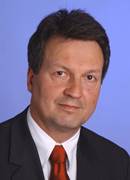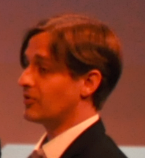Keynote Lectures
- Aircraft Engine Advanced Health Management: The Power of the Foresee-
by Inaki Ulizar
- Aspects of Automatic Flying with Lessons Learnt from Barracuda-
by Thomas Gottmann
- Prognostics and Health Management (PHM) and Health and Usage Monitoring Systems (HUMS): Thales Perspective-
by Pierre-Olivier Robic
The Keynote Lecture session is tagged as a keystone event of PHME16. In this session, experts from different domains provide new insights on the pervasive use of health management methods and technologies. In PHME16, the Keynote Lecture session will take place on Thursday, July 7 evening. These lectures are intended not only to highlight the inter-disciplinary aspect of health management, but also promote an interchange of ideas that span diverse application domains.
| Thursday, July 7, 2016 |
16h30–18h00 |
| 16h30–16h35 |
Session Introduction |
| 16h35–17h00 |
Dr. Inaki Ulizar Chief Technology Officer, ITP, Madrid, Spain
|
Aircraft Engine Advanced Health Management: The Power of the Foresee
Abstract: Over the last few decades, a significant change in the business model of the aircraft engine companies has taken place. The relative importance of the fly by the hour (FBH) or power by the hour (PBH) type of approach has grown from being relatively marginal to be, in many cases, the main source of income and an essential tool to improve reliability and safety aspects. In terms of maintenance, a direct consequence has been the transformation from a mostly preventive maintenance, where the engine was refurbished at fixed intervals, and the actions at each interval were generally predetermined, to a predictive model. To handle these changes, the original Engine Health Monitoring has evolved to an Engine Health Management, both of them preserving the EHM acronym.
Some real examples are provided to show how the EHM is able to help in normal operation and also under failure conditions.
Finally, some considerations are made about the future challenges and opportunities of the EHM. All these aspects will be complemented by new on-wing inspection and repair capabilities. A step change is therefore expected in the reliability parameters of the aircraft engine sector, which will be of paramount importance considering the continuous growth of the sector. |
| 17h00–17h05 |
Session Introduction |
| 17h05–17h30 |
Thomas Gottman Airbus Defence and Space |
Aspects of Automatic Flying with Lessons Learnt from Barracuda
Abstract: The key note presentation introduces first Barracuda UAS technology demonstrator project and how it is placed within the overall Airbus UAS portfolio and continues with the experiences and lessons learnt during testing of Barracuda. The aspects and especially the challenges of automatic / autonomous flying with Barracuda system are highlighted and the opportunities and meaning for health monitoring and prognostics are derived in a first attempt. Main focus is on autonomy / automation in respect to flight safety and mission (contingency) planning. Finally an outlook will be given on the near to mid-term availability of Health Monitoring and Prognostics functions at Airbus.
 Biography: Thomas Gottmann studied Aerospace Engineering, graduated at Technical University in Munich and started his career at Airbus Defence & Space (former MBB) aerodynamics department in 1985. He changed to Conceptual Design Department in 1995, where he was responsible for design development software and for the conceptual design & analysis of aircraft and space re-entry configurations. In 1998 he started his work on unmanned aerial systems, taking over the role as Technical Manager in BARRACUDA program in 2002. From 2006 to 2015 he was program manager of Barracuda and of German Government funded Generic System Demonstrator ‘Agile UAV in Network Centric Environment (NCE)’. Agile UAV in NCE was successfully completed with end 2015, Barracuda is still available for further UAS test campaigns. Biography: Thomas Gottmann studied Aerospace Engineering, graduated at Technical University in Munich and started his career at Airbus Defence & Space (former MBB) aerodynamics department in 1985. He changed to Conceptual Design Department in 1995, where he was responsible for design development software and for the conceptual design & analysis of aircraft and space re-entry configurations. In 1998 he started his work on unmanned aerial systems, taking over the role as Technical Manager in BARRACUDA program in 2002. From 2006 to 2015 he was program manager of Barracuda and of German Government funded Generic System Demonstrator ‘Agile UAV in Network Centric Environment (NCE)’. Agile UAV in NCE was successfully completed with end 2015, Barracuda is still available for further UAS test campaigns.
|
| 17h30–17h35 |
Session Introduction |
| 17h35–18h00 |
Dr. Pierre-Olivier Robic Thales |
Prognostics and Health Management (PHM) and Health and Usage Monitoring Systems (HUMS): Thales Perspective
Abstract: Driven by consumer market (Cars, Domestic Appliances, etc.), the Internet of Things and Big Data technology, Prognostics and Health Management (PHM) is becoming increasingly common, even for Thales Markets. This presentation aims to present the activities in progress at Thales Group Level in the frame of Health and Usage Monitoring Systems (HUMS), Prognosis & System Monitoring. We present firstly the Group HUMS Project organization & plan, and an highlight of some outcomes related to Functional Architecture and Technology. Then we present the Thales experience in terms of projects through some key industrial projects including PHM considerations. The first detailed example is based on Land Vehicles and the second one is based on UAV. In the last part of the presentation, we address the research side of the project including an overview presentation of the algorithms taxonomy and also an highlight on some PhD under progress in the landscape of the « Model-Based System Management » & on « predictive maintenance algorithms » and « information quality ».
 Biography: Pierre-Olivier ROBIC has worked for Thales for four years in the Service directorate. He is responsible for Future Service at Group level and the Group lead for the HUMS initiative. Previous to this, he has worked for BNAE, French Standardisation association for Aerospace, in Charge of Program Management & System Engineering, Organisation Management & Information Technology. He has a Master of Science in Telecommunication & Networks from ECE and a Master of Economics from Pierre Mendes France University. He is also member of AFIS (French body of INCOSE – System Engineering), IMdR (Risk Management Institute) and IHEDN (Institute of High Study for French Defense). Biography: Pierre-Olivier ROBIC has worked for Thales for four years in the Service directorate. He is responsible for Future Service at Group level and the Group lead for the HUMS initiative. Previous to this, he has worked for BNAE, French Standardisation association for Aerospace, in Charge of Program Management & System Engineering, Organisation Management & Information Technology. He has a Master of Science in Telecommunication & Networks from ECE and a Master of Economics from Pierre Mendes France University. He is also member of AFIS (French body of INCOSE – System Engineering), IMdR (Risk Management Institute) and IHEDN (Institute of High Study for French Defense).
|

 Biography: Thomas Gottmann studied Aerospace Engineering, graduated at Technical University in Munich and started his career at Airbus Defence & Space (former MBB) aerodynamics department in 1985. He changed to Conceptual Design Department in 1995, where he was responsible for design development software and for the conceptual design & analysis of aircraft and space re-entry configurations. In 1998 he started his work on unmanned aerial systems, taking over the role as Technical Manager in BARRACUDA program in 2002. From 2006 to 2015 he was program manager of Barracuda and of German Government funded Generic System Demonstrator ‘Agile UAV in Network Centric Environment (NCE)’. Agile UAV in NCE was successfully completed with end 2015, Barracuda is still available for further UAS test campaigns.
Biography: Thomas Gottmann studied Aerospace Engineering, graduated at Technical University in Munich and started his career at Airbus Defence & Space (former MBB) aerodynamics department in 1985. He changed to Conceptual Design Department in 1995, where he was responsible for design development software and for the conceptual design & analysis of aircraft and space re-entry configurations. In 1998 he started his work on unmanned aerial systems, taking over the role as Technical Manager in BARRACUDA program in 2002. From 2006 to 2015 he was program manager of Barracuda and of German Government funded Generic System Demonstrator ‘Agile UAV in Network Centric Environment (NCE)’. Agile UAV in NCE was successfully completed with end 2015, Barracuda is still available for further UAS test campaigns. Biography: Pierre-Olivier ROBIC has worked for Thales for four years in the Service directorate. He is responsible for Future Service at Group level and the Group lead for the HUMS initiative. Previous to this, he has worked for BNAE, French Standardisation association for Aerospace, in Charge of Program Management & System Engineering, Organisation Management & Information Technology. He has a Master of Science in Telecommunication & Networks from ECE and a Master of Economics from Pierre Mendes France University. He is also member of AFIS (French body of INCOSE – System Engineering), IMdR (Risk Management Institute) and IHEDN (Institute of High Study for French Defense).
Biography: Pierre-Olivier ROBIC has worked for Thales for four years in the Service directorate. He is responsible for Future Service at Group level and the Group lead for the HUMS initiative. Previous to this, he has worked for BNAE, French Standardisation association for Aerospace, in Charge of Program Management & System Engineering, Organisation Management & Information Technology. He has a Master of Science in Telecommunication & Networks from ECE and a Master of Economics from Pierre Mendes France University. He is also member of AFIS (French body of INCOSE – System Engineering), IMdR (Risk Management Institute) and IHEDN (Institute of High Study for French Defense).